(1)A decimal number is a number which has two parts, ie, whole number part and fractional part. These parts are separated by point notation. This point notation is known as decimal. The numbers which have decimals are called decimals numbers.
Eg:- 25.56 is a decimal number
(2) Whole number part comes before decimal or at left side of decimal. Fractional part or decimal part comes after decimal or at right side of the decimal.
Eg:- 25.56 is a decimal number
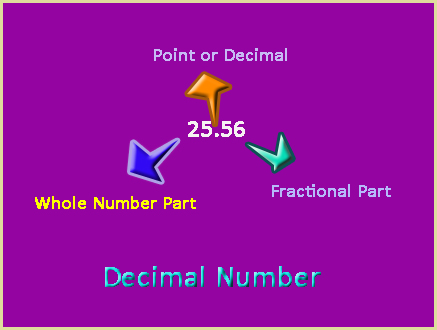
(3)Place value of the decimal numbers
Whole Numbers presents ones, tens, hundreds, thousands etc position or places of digits. Decimal numbers presents one – tenths, one – hundredths, one -thousandths etc positions or places of digits. One tenths position is just after the decimal point, one – hundredths come after it and this process is followed by other positions also.
Eg:- 125.567is a decimal number
125 is whole number part.
.567 is fractional part or decimal part



(4)Reading of decimal numbers
Decimal is pronounced as point. Number after decimal reads separately.
Eg:- 56.234
To read this number we first pronounced whole number part as a number,ie, fifty six in our example. Then we will pronounce decimal as point.
Then we read numbers after decimal as two, three, four.
Therefore, we will pronounce 56.234 as fifty six point two three four.



(5) Comparing of the decimals numbers
For comparing numbers first compare numbers on the left side of decimal and then compare numbers on the right side of decimals. To compare number on the right side first compare number at tenths place than at hundredths place and continue this process till we get answer.

(6)Addition of the decimals Numbers
Procedure of addition of decimals numbers is similar to addition of whole numbers.
Step 1:
First add numbers at fractional part or at right side of decimals.
Step 2
Now, add numbers of whole numbers part.
Eg:- Add 23. 56 and 34.12
Ans-
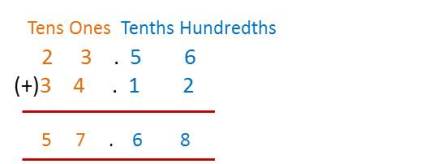
(ii) Addition of the decimal numbers with carryover
Step 1
First add numbers at fractional part or at right side of decimals.
Step 2
Now, add numbers of whole numbers part .Add carryover of fractional part also with the sum of ones of whole number part.
Eg:- Add 56.234 and 45.782
Ans-

(7)Subtraction of decimal numbers
Procedure of subtraction of decimals numbers is similar to subtraction of whole numbers.
(i)Subtraction of the decimal numbers without borrowing
Step 1:
First subtract numbers at fractional part or at right side of decimals.
Step 2
Now, subtract the numbers of whole numbers part.
Eg:- Subtract 34.01 from 67.09
Ans-
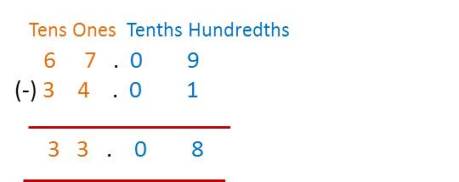
(ii)Subtraction of the decimal numbers with borrowing
Step 1:
First subtract numbers at fractional part or at right side of decimals.
Step 2
Now, subtract the numbers of whole numbers part .Borrow numbers from fractional par.
Eg:- Subtract 45.67 from 87.02
Ans-
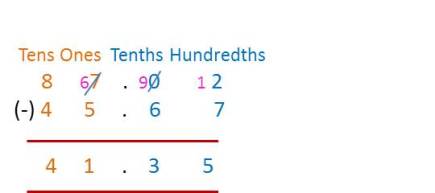
(8)Multiplication of Decimal Numbers
(i) Multiplication of decimal numbers by whole number
Step 1
Multiply whole number digits without putting decimal.
Step 2
Count digits of decimal number form right of decimal [Fractional Part].
Step 3
Count multiplication digits from ones and put decimal where it equals with counted digits of fractional part.
Eg:- Multiply 2.03 by 2
Ans-

(ii) Multiplication of decimal numbers by decimal numbers
Step 1
Multiply whole number digits without putting decimal.
Step 2
Count digits of both numbers together of fractional part.
Step 3
Count multiplication digits from ones and put decimal where it equals with counted digits of fractional part.

Ans-
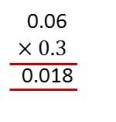

Ans-

(iii)Multiplication of decimal Numbers by 10, 100, 1000
Step 1
Product of digits is same as in the decimal number.
Step 2
Decimal point in the product is shifted to the right by as, many of places as there is zero over one.
Eg-

(9)Division of decimal numbers
(i)Division by 10,100 and1000
Step 1
The digits of the number and quotient are same.
Step 2
The decimal point will be place where number of zero equals the places of digits from extreme right.
Eg:-

(ii)Division by any whole number
(a) If remainder is zero
Eg:- 24.2 is divided by 2
Step1
Divide whole part of the number by 2.

Step 2
Put point in quotient.

Step 3
Divide fractional part as we do in whole numbers.

(b) If remainder is not zero
Eg:- Divide 54.67 by 12
Ans-
Step 1
Divide whole part of the number by 12.
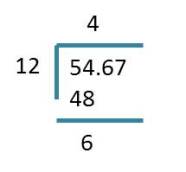
Step 2
Put point in quotient.

Step 3 –
Divide fractional part as we do in whole numbers. If any digit remains in remainder other than zero, use zero with remainder at ones place and divide it with divisor. We can take zero after putting point in quotient.
We can continue division by adding zero at ones place of remainder but no need to do division more than three places until mentioned in question.

(iii)Division of decimal numbers by decimals numbers
Eg:- Divide 64.02 by 12.32
Ans-
Step 1
To remove decimals count digits after decimals if they are same just remove decimal and divide following same processor of division of whole numbers.

We can solve it by two methods
Method 1
Step 1
Divide as in whole numbers.
Step 2
Put decimal in quotient if get remainder.
Step 3
After putting point or decimal in quotient take zero with remainder at one place and divide.
Repeat this process up to three point of decimal.

Method 2
Step 1
First reduce it to lowest form and then divide as in whole numbers

Step 2
Divide 1603 by 308
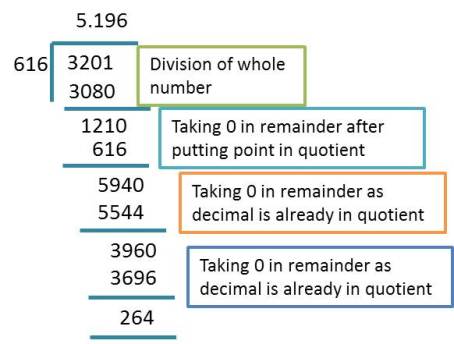
Helping Topics
